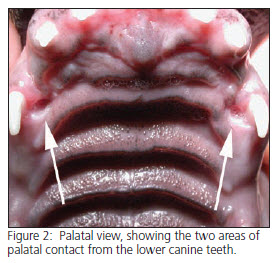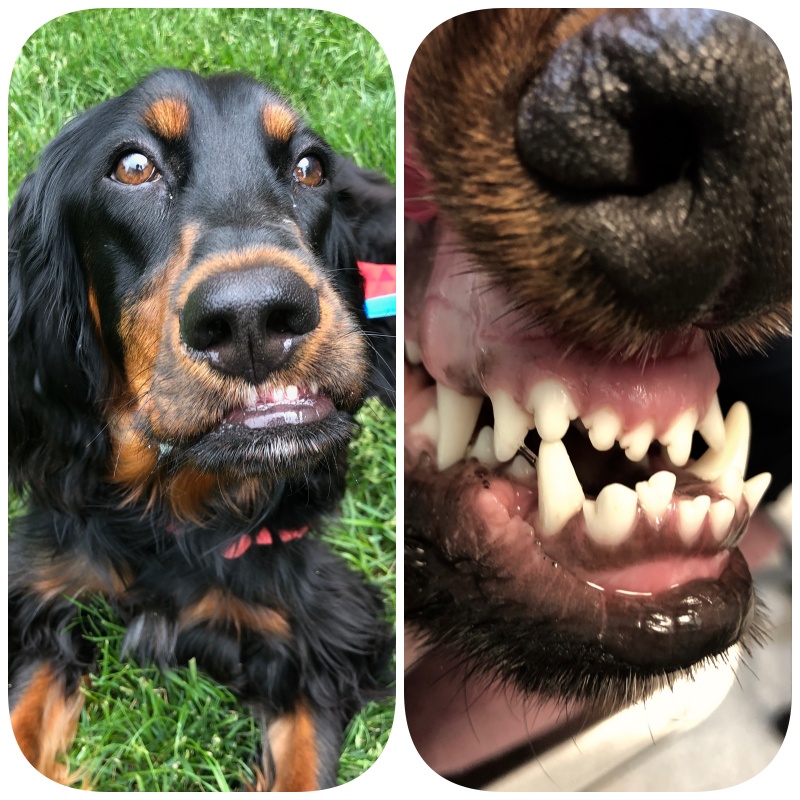class ii malocclusion dog
Normally the teeth interact in a manner that allows for powerful chewing and tearing of food. In order to detect a malocclusion it is important for veterinary surgeons and veterinary nurses to have an understanding both of normal occlusion and of the classification.

That Bites Dental Malocclusions And Abnormal Bites In Pets Vet In Aurora The Animal Dental Clinic
Impression of a true skeletal Class II malocclusion.

. A Class 1 malocclusion linguoversion of tooth 704 in a 10-week-old golden doodle. The mandible resides distal caudal to its normal location in relation to the maxilla Photo 5. 1 maxillo-mandibular relationship mandibular retrognathism midface protrusion or both.
Class II Malocclusion. This often results in mandibular canine teeth traumatizing the palate. Skeletal Class II malocclusions can be found to have variants in one or more of the following regions.
Malocclusion - rotation of right upper canine 104. Though any dog or cat may suffer from dental malocclusion this is considered a very common disorder in the world of purebred dogs. Even the lower incisors can be a problem as they can get hung up behind the palatal rugae and incisive papilla.
Depending on the class of malocclusion palatinegingivalliptooth trauma can occur. Terms that have commonly been associated with class II. Author Graham Thatcher 1 Affiliation 1 Dr.
Orthodontic presentation is possible but class II overjet III underjet and linguoversed mandibular canines are the most common presentations. Treatment options vary for each type of malocclusion. Malocclusion in dogs is commonly diagnosed in puppies when the primary dentition is present.
This happens when the maxilla is longer than the mandible. Class II Malocclusion Distocclusion Mandibular Brachygnathism Mandibular Retrusion--Overshot The mandible is too short relative to the maxilla. Mandibular distoclusion Class 2 malocclusion.
Lingually displaced 404 canine. Malocclusion involves abnormal relationships of teeth to each other and other oral structures. The mandible is short with respect to its normal position with the maxilla.
B Mild Class 2 malocclusion in a 55-month-old mixed-breed dog. The mandible resides distal caudal to its normal location in relation to the maxilla Photo 5. The American Veterinary Dental College defines Class II malocclusion as mandibular distocclusion when there is an abnormal rostro-caudal relationship between the dental arches in which the mandibular arch occludes caudal to its normal position relative to the maxillary arch Figure 3.
The amount of space between the maxillary and the mandibular incisors varies with the severity of the condition. A Class 1 malocclusion linguoversion of tooth 704 in a 10-week-old golden doodle. Therefore the mandibular incisors do not touch the cingulum of the maxillary incisors.
Any dog can develop malocclusion though it is normal for certain breeds to have a non-scissor bite these include Boxers Lhasa Apsos and Shih Tzus. In rostral crossbite cases similar to anterior crossbite in people one or more of the mandibular incisor teeth are labial to the opposing maxillary incisor teeth when the. Brachycephalic breeds like Pugs and Bulldogs have a higher risk for developing an underbite as do Boston Terriers Pekingese and Cavalier King Charles Spaniels.
Photos courtesy John Lewis. The majority of malocclusion cases result. Mandibular distoclusion Class 2 malocclusion.
With a class 2 malocclusion in which the lower canines are penetrating the palatal mucosa this effectively staples the mandible to the maxilla s in that relationship an abnormal dental interlock. 2 the cra-nial base increased length of the anterior cranial base. A malocclusion in which a mandibular tooth or teeth have a more buccal or labial position than the antagonist maxillary tooth.
Class II malocclusions are considered overbites in dogs and cats. In this type of malocclusion the mandible and the maxilla are of equal lengths but one or more teeth are misaligned. Mandibular distoclusion Class 2 malocclusion.
I saw a 10-week-old puppy recently with a malocclusion that. Class III malocclusions are considered underbites in dogs and cats. Terms that have commonly been associated with class II.
Diagnosis and management of Class II malocclusion Can Vet J. It can be classified as rostral or caudal. Abnormal jaw growth or misalignment of the teeth themselves can result in teeth that do not align in the correct fashion.
Figure 2a One major difference between adult and deciduous malocclusions is the anatomy of the teeth involved. The mandibles are longer in respect to their normal relationship to the maxilla. Malocclusion results when the upper teeth do not align properly with the lower teeth.
Class II malocclusion. Some of the various treatment options include extraction of the offending tooth or teeth removing the crown of a tooth and performing. Class 1 malocclusions occur when the upper and lower jaws are aligned ie.
This often results in mandibular canine teeth traumatizing the palate. This is a type II malocclusion in a dog- the lower jaw is shorter than the upper jaw by about 1 inch. Malocclusion can present without significant symptoms or can be severely debilitating.
Class II malocclusion 02. Thatcher is an Assistant Professor Dentistry and Oral Surgery University of Wisconsin School of Veterinary Medicine Madison Wisconsin 53706 USA. In the dog the ideal tooth positions in the arches are defined by the occlusal interarch and interdental relationships of the teeth of the archetypal dog ie wolf.

Canine S Classification Download Scientific Diagram

Class Ii Div Ii Malocclusion See You In 2 Years R Invisalign
Cookie S Canine Teeth Is Heckin Weird Poodle Forum

Bite Abnormalities In Dogs Advanced Animal Dentistry

Dog Malocclusion Animal Dentistry Oral Surgery Wisconsin Oshkosh Green Bay Glendale Greenfield Minnesota

Recognising Malocclusion In Dogs And Cats Veterinary Practice

Maxillary Canine Tooth Extraction For Class 2 Malocclusion In A Dog Semantic Scholar

Normal Occlusion And Common Malocclusions Wsava2010 Vin

Interceptive Orthodontics Montana Pet Dentistry Oral Surgery

Feature Oral Health Issues In The Dog Developmental Abnormalities Malocclusions By David E Hansen Dvm Favd Davdc

Defining Dental Malocclusions In Dogs

Malocclusions Misaligned Teeth Animal Dental Specialist

Malocclusion In Dogs And Cats The Veterinary Nurse

Read This Dentistry Article By Katie Rankin Bs Rvt
Helping Your Puppy With Teeth Misalignment Malocclusions

Canine Classification A Class I Canine With The Maxillary Canine Download Scientific Diagram
Puppy Dental Malocclusion Deciduous Mandibular Canine And Incisor Teeth Extraction And Permanent Canine Teeth Crown Extensions The Australian Veterinarian Magazine

